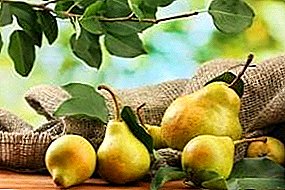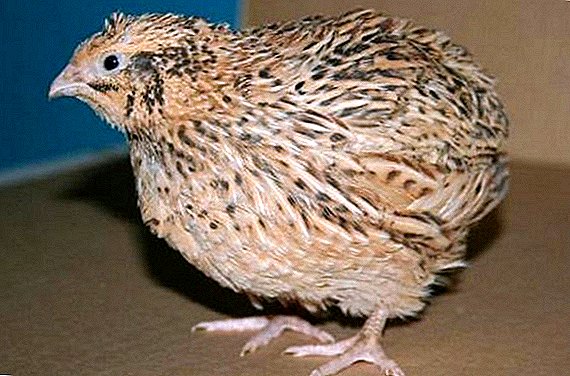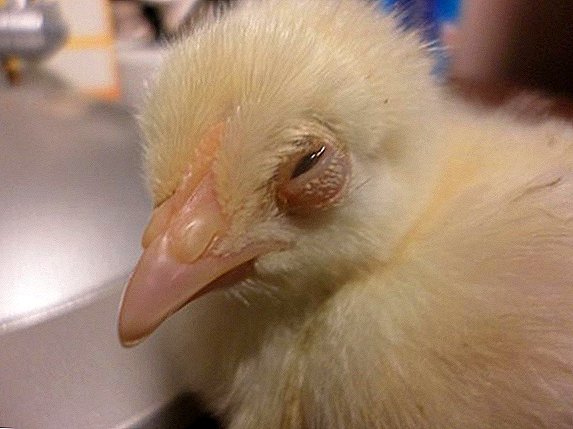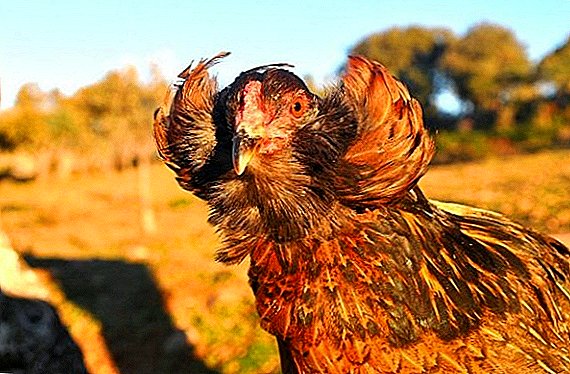 In the world there are more than 700 breeds of chickens that are bred as meat and egg breeds, but a lot of them are also displayed for decorative purposes.
In the world there are more than 700 breeds of chickens that are bred as meat and egg breeds, but a lot of them are also displayed for decorative purposes.
Today we will look at the description of the breed of Arakan chickens, which has an excellent decorative appearance and provides their owner with unusual eggs, as for chicken eggs, colors.
History reference
 Araucana is considered oldest breed of chickenswhich first appeared on the South American continent, in Chile. It is known that the breed was created thanks to a tribe of Indians Araucan who inhabited the foot of the Andes. In creating the breed, people were guided by the result that allowed them to get tailless individuals - roosters and hens, which carried eggs of blue and green shades.
Araucana is considered oldest breed of chickenswhich first appeared on the South American continent, in Chile. It is known that the breed was created thanks to a tribe of Indians Araucan who inhabited the foot of the Andes. In creating the breed, people were guided by the result that allowed them to get tailless individuals - roosters and hens, which carried eggs of blue and green shades.
Did you know? Tailless cocks in the tribe were especially valued, as they participated in cockfighting, and in this case the tail prevented the fighting spirit and strength from being shown.
The early history of the breed itself is not documented. In 1914, in Chile, chickens were found by the poultry farmer Salvador Castello. At first, the breed was considered a separate species of chickens, in 1924 the specific name Gallus inauris was adopted, but later it was established that the Araukana belong to the species domestic chickens.
For a long time, scientists could not make out what was the reason for the particular color of the eggshell of this breed. Some hypothesized that the chickens were crossed with wild pheasant, as a result of which a rare mutation occurred and the eggs acquired a particular color. This fact has not been scientifically confirmed, so researchers are inclined to believe that the oviduct in the hens contains biliverdin, a pigment that can stain the eggs.
In Germany in 1965 the breed was introduced to the German standard of birds. In 1975, the Araucan dwarf breed was created in the USA, and in 1984 it was included in the list of breeds of chickens created in the USA. 
Characteristics and features
Like any other breed of chickens, the araucana has its own characteristic features, which make it possible to distinguish individuals of this breed from any other, therefore, we consider the description of the appearance of the representatives, as well as the distinctive features of the rooster and hen.
Appearance
Given the fact that the breed is standardized, Arakan chickens are very similar to each other. The main feature of the appearance of the bird is lack of caudal vertebrae, therefore you will not see the tail on chickens visually. This is a special dominant trait, which is necessarily inherited in the breeding process.
Did you know? The absence of a tail is a feature of the exclusively German standard hen of an Araucan, the American standard, on the contrary, implies the presence of a tail and a small tuft on the head.
Since Araucans are only distributed according to the German standard in the world, their description is taken as a basis. As already mentioned above, real layer araucans can carry eggs of green-bluish tones, which is the main feature by which these chickens became so popular in different parts of the world.  Araucans are endowed with a head of small size, which is characterized by the presence of well-defined, long feather whiskers. Eyes roundish, orange-red, medium length of beak, slightly bending down. Chickens have a small pod-like or pea-shaped comb, small earrings hanging from the ears. The body is short and stocky, has a not long neck, a wide and straight back, an undeveloped tailbone, a broad chest, wings of moderate length, tight to the body. Individuals have strong legs, blue-green color, no feathers, each lamp has four fingers.
Araucans are endowed with a head of small size, which is characterized by the presence of well-defined, long feather whiskers. Eyes roundish, orange-red, medium length of beak, slightly bending down. Chickens have a small pod-like or pea-shaped comb, small earrings hanging from the ears. The body is short and stocky, has a not long neck, a wide and straight back, an undeveloped tailbone, a broad chest, wings of moderate length, tight to the body. Individuals have strong legs, blue-green color, no feathers, each lamp has four fingers.
The hens of Chinese silk breeds, barnevelder, silver pretzel, bielefelder, Pavlovskaya, dominants have a decorative appearance.
Rooster and chicken: the differences
The rooster and chicken of the Araucan breed are very similar, which is related to the breed standard. Representatives of male and female are different in weight: hens can weigh about 1, 5 kg, roosters grow large sizes - up to 2-2.5 kg. The rooster has more powerful paws and beak, which is stronger than that of the chicken, bent downwards. The main differences between the male and female representatives of this breed are in the color and character of the birds. 
Color
According to the standard, the color of the plumage can be golden, silver, black, white, blue and all sorts of combinations of the above colors. Both hens and roosters can be of various colors and combine several colors. Often the color of roosters is darker, more saturated and can combine in itself contrasting colors - light and dark. In general, the color of the rooster looks more interesting and attracts more attention than the color of the plumage of the chicken. 
Character
The character of the male and female Araucan breed is radically opposite. If the hens behave in an appealing manner, gently, calmly, and peacefully, they get along with other breeds, without attracting special attention, the roosters are very conflicted, they hooligans and fight with their rivals, especially with other breeds. Roosters in this case are absolutely fearless and without any problems enter into a fight with stronger opponents, they can even pounce on people if they feel the danger. 
Puberty and egg production
Araucans puberty occurs at a fairly early age - 6 months. At this time, the hens can begin to lay eggs. Normal is delayed development, in which case chickens are able to reproduce eggs at 9 months of age. The main reason for the delayed sexual development of Araucans is obesity, when birds are overfeeding and offer high-calorie food.
In legbar breeds, the eggs can range from light turquoise to olive, while maran breeds have a dark brown color.
Throughout the year, the hen can produce about 180 eggsthat weigh as eggs of ordinary breeds - from 50 to 70 g.  Araucan eggs have absolutely no difference in taste from ordinary chicken eggs, the color we are used to, although breeders actively impose the view that eggs of this breed are more useful.
Araucan eggs have absolutely no difference in taste from ordinary chicken eggs, the color we are used to, although breeders actively impose the view that eggs of this breed are more useful.
Did you know? When it is warm outside, the Arakan chickens carry eggs of a brighter color, but with the onset of cold weather the color becomes less intense, which is justified by the effect of lack of sunlight on the amount of pigment produced.
Hatching instinct
In the process of breeding, the incubation instinct of the Araukans was partially lost, which causes many difficulties in the process of breeding this breed. Breeders note that about 1 laying hens in 1 individual show an inclination towards motherhood, in which case it is even possible to develop the problem of false incubation of eggs.
Learn more about growing chickens in an incubator: incubator selection criteria and characteristics of the best devices; advantages of using incubators "Laying", "Ideal hen", "Cinderella", "Blitz".
Conditions of detention
In order to contain this breed of chickens, it is necessary to provide it with some conditions that allow the bird to feel comfortable, which will contribute to normal egg production and better incubation of the offspring.
Coop Requirements
When arranging a chicken coop, it is necessary to take into account the nature of the breed and limit the proximity to other chickens. The size of the chicken coop should not be very large - it is necessary to allocate one square meter for three individuals. When setting up a chicken coop, place the perches and nests in it, it is better to attach them to the height and keep the dimensions. It is necessary to allocate 30 cm perch per individual and one nest for 5 layers.  The ideal floor for keeping chickens in a chicken coop is wooden. The tree retains heat well and does not need extra bedding, as is the case with the concrete floor. Such material is eco-friendly, to build a floor of wood is quite simple with his own hands. Place in the hen house a sufficient amount of feeders and drinkers, which should be washed from time to time and treated with disinfectants. The optimum temperature for keeping birds is + 16 ° ... + 20 ° С.
The ideal floor for keeping chickens in a chicken coop is wooden. The tree retains heat well and does not need extra bedding, as is the case with the concrete floor. Such material is eco-friendly, to build a floor of wood is quite simple with his own hands. Place in the hen house a sufficient amount of feeders and drinkers, which should be washed from time to time and treated with disinfectants. The optimum temperature for keeping birds is + 16 ° ... + 20 ° С.
Tips on home equipment for chickens: choosing and buying a chicken coop; self-production and arrangement of the chicken coop, the provision of ventilation.
Walking yard
A compulsory condition for keeping chickens of the Araucan is the availability of a spacious place for walking, so that the bird can at any moment move from the hen house to the spacious territory. The place for walking is recommended to be fenced with a net-rabits from all sides.to protect the birds from predators. Part of the territory is advised to be equipped with a canopy, so that in summer, in the heat, the bird can take shelter in a shaded place. On the territory for walking it is necessary to install feeding troughs in order for chickens to have unhindered access to water and food. 
How to endure the winter cold
This breed tolerates frosts, easily withstands a decrease in temperature to -6 ° C. In such weather, Araucans can freely walk on the street, in the walking yard. When the air temperature drops and becomes below -6 ° C, it is necessary to provide a warm chicken coop, for this it is warmed, a layer of straw is poured on the floor.
We advise you to read about the measures of keeping chickens in winter: winter care, the construction of a winter chicken coop, heating.
What to feed
It is very important to provide high-quality food to the bird in order to achieve good egg production and normal growth and development of individuals.
Chickens
When chicks just hatched, they have a fragile body with a weak digestive system. At this time they are recommended to feed. steamed corn grits, which is poured on the bottom of the box, where the kids were placed.
On second day of life Chickens are fed with corn grits, to which they add barley, wheat grits, grind oatmeal flakes, add a little of decoy and millet, mix everything thoroughly. It is necessary to offer food to babies very often, in small portions, the optimal feeding periods - every 2 hours. In the diet you can add cottage cheese, which is given in the morning, a little cereal is mixed into it. Liquid kefir or whey is poured into the drinkers so that the body receives the necessary amount of calcium for the normal process of bone formation.  On 5th day of life It is possible to add fresh greens to the habitual for kids nutrition, for this purpose plantain leaves, clover, dandelion, green stalks of onions are suitable.
On 5th day of life It is possible to add fresh greens to the habitual for kids nutrition, for this purpose plantain leaves, clover, dandelion, green stalks of onions are suitable.
WITH 10th day of life portions can be made more, add boiled cereal to the ration. Do not forget to feed Araucan greens and dairy products.
AT monthly age it is possible to gradually transfer chicks to coarse grains, it was initially mixed in a mixture of cereals, which were given earlier. It is possible to offer whole grains at the age of 1.5 months, it is recommended to add wet mash and bone meal to the menu.
In order for the chickens to grow healthy and strong, you should install a separate container with sand, small gravel or small shell, which Araucan eat with pleasure.
Read also about the feeding of laying hens: the rate of feed for a day, how to make feed for laying hens at home.
Adult chickens
The nutrition of adults is traditional and does not differ from the nutrition of ordinary chickens. Food should be divided into 3 doses - this option is optimal in order to preserve the productivity of araukans. In the morning and in the evening dry grain is offered to the birds, at lunch - a wet mash. In summertime, chickens are given a variety of greens, such as chickens, which allows you to saturate the body with vitamins and minerals necessary for the normal functioning of the bird.  In winter, the Araucan recommended to give a pumpkin, grated root vegetables, fish meal. It is useful to give adult food waste from the table - fish, meat, vegetables. Be sure to provide chickens with free access to clean fresh water, change it regularly and wash the container. Place a feeder with fine gravel in the bird’s habitat to facilitate the process of digesting the chickens.
In winter, the Araucan recommended to give a pumpkin, grated root vegetables, fish meal. It is useful to give adult food waste from the table - fish, meat, vegetables. Be sure to provide chickens with free access to clean fresh water, change it regularly and wash the container. Place a feeder with fine gravel in the bird’s habitat to facilitate the process of digesting the chickens.
Important! Regularly clean the feeders of old food that is fermented or moldy, since such food is very dangerous and may even lead to the death of chickens.
Propensity to disease
Breed has good health and rarely undergoes illness. The only problem that often occurs in birds is the appearance of parasites. To avoid contamination, it is recommended to regularly treat the room and feathers of chickens.
Often chickens become infected worms, individuals become inactive, eat poorly. In order to detect the presence of worms, a bird must be examined by a veterinarian who prescribes anthelmintic therapy to the whole herd at once. Sometimes lnterflies settle on the feathers of birds, which affect the state of individuals, they eat poorly, fuss, and itch. In this case, the feathers and the chicken coop are treated with a special agent purchased in a vet pharmacy.
The most dangerous parasite in chickens is considered feather mite. Birds begin to lose feathers en masse, which leads to complete baldness. It is impossible to cure a hen from a feather mite, therefore it is killed so that no other individuals become infected. 
Advantages and disadvantages
If you are planning to buy Araukan chickens for home maintenance, you need to consider all the pros and cons, so that in the end you will not be disappointed and not regret the money spent.
TO merits breeds include:
- ease of care;
- undemanding to conditions of detention;
- the onset of egg production at the age of 6 months;
- breed decoration;
- unusual color of eggs;
- insensitivity to temperature changes.
TO disadvantages breeds include:
- aggressive character of roosters;
- absence of incubation instinct in the hens;
- the high cost of young animals and eggs due to the rarity of the breed.
Important! There are difficulties fertilizing eggs with roosters, as the hen cloaca in the hen is heavily overgrown with feathers. To avoid this situation, it is recommended to cut the problem area once a month.
Video: Araukan hens
Experience breeding akaukana: reviews


Thus, Araucans differ from ordinary chickens only in appearance and certain characteristics, and everyone can keep them at home because they do not need to provide special conditions or bother with food.












